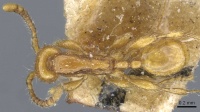Aenictus rixator
| Aenictus rixator | |
|---|---|

| |
| Scientific classification | |
| Kingdom: | Animalia |
| Phylum: | Arthropoda |
| Class: | Insecta |
| Order: | Hymenoptera |
| Family: | Formicidae |
| Subfamily: | Dorylinae |
| Genus: | Aenictus |
| Species group: | rixator |
| Species: | A. rixator |
| Binomial name | |
| Aenictus rixator Forel, 1901 | |
This species is known from only a single specimen collected in South Africa in 1915.
Identification
Gómez (2022) - A member of the Aenictus rixator species group. Its size, short scapes, overall aspect, colour and distribution could suggest the species in the mariae species complex as the closest relatives, but can be separated from them by the absence of a row of triangular teeth at the clypeus, the linear long mandibles (triangular in the mariae complex), with reduced dentition (three teeth against one apical and 4-8 denticles) and the presence of a clearly defined propodeal ridge.
Keys including this Species
Distribution
Identification
Keys including this Species
Distribution
Latitudinal Distribution Pattern
Latitudinal Range: -29° to -29°.
| North Temperate |
North Subtropical |
Tropical | South Subtropical |
South Temperate |
- Source: Gomez, 2022
Distribution based on Regional Taxon Lists
Afrotropical Region: South Africa (type locality), South Africa (type locality).
Distribution based on AntMaps
Distribution based on AntWeb specimens
Check data from AntWeb
Countries Occupied
| Number of countries occupied by this species based on AntWiki Regional Taxon Lists. In general, fewer countries occupied indicates a narrower range, while more countries indicates a more widespread species. |

|
Estimated Abundance
| Relative abundance based on number of AntMaps records per species (this species within the purple bar). Fewer records (to the left) indicates a less abundant/encountered species while more records (to the right) indicates more abundant/encountered species. |

|
Biology
Castes
Known from the worker caste. Table of castes known for all Afrotropical Aenictus species.
Nomenclature
The following information is derived from Barry Bolton's Online Catalogue of the Ants of the World.
- rixator. Aenictus rixator Forel, in Emery, 1901d: 48 (w.) SOUTH AFRICA.
- Type-material: holotype worker.
- Type-locality: South Africa: Natal (R.C. Wroughton).
- Type-depository: MHNG.
- Status as species: Emery, 1910b: 31; Arnold, 1915: 137; Wheeler, W.M. 1922a: 754; Bolton, 1995b: 60; Gómez, 2022: 47 (redescription).
- Distribution: South Africa.
Unless otherwise noted the text for the remainder of this section is reported from the publication that includes the original description.
Description
Worker
Gómez (2022) - HL: 0.44; HW: 0.4; SL: 0.26; WL: 0.67; PL: 0.16; PH: 0.12; PPL: 0.12; PPH: 0.11; CS: 0.42; CI: 90; SIL: 60; SIW: 66; WL/HW: 166; PI: 133; PPI: 109 (n=1).
With the characters defined for the rixator group and: short scapes, slightly surpassing the middle of the head when laid back (SIL~60). Funicular segments wider than long, preapical subquadrate, apical more than twice longer than wide. Head longer than wide (CI~90), subrectangular, slightly wider at its middle, occipital line straight. Ventrolateral margin present but weak, not extending ventrally. Mandibles armed with three teeth.
Frontal ridges present, almost fused at its middle section and diverging again apically, its distal section elevated forming a low ridge overhanging from clypeus; parafrontal ridges present but very weak. Propodeal ridge present and clearly demarcated laterally and dorsally. Petiole with anterolateral, anterodorsal and dorsolateral carina present, the latter weak and discernible as a darker straight line in lateral and dorsal view reaching the spiracle; petiolar dome elliptical in lateral view, the anterior face straight sloping 45 degrees aprox. Posterior face vertical. Postpetiole subrectangular with vertical anterior and posterior face, the anterior angle with the dorsal surface obtuse and the posterior square, both rounded.
Subpetiolar process present but poorly developed, as a quarter of ellipse with its anterior face vertical and straight, without lamella, its size about the size of the prora.
Yellow to light brown, becoming yellowish red at the pronotum, sutures and patches of the head. Glassy smooth overall. Mesopleurae, pronotum and lateral zones of petiole and postpetiole faintly and patchy alutaceus to faintly reticulated.
Whole body covered with yellowish, fine setae, smaller than petiole height; semi erect to decumbent in mesosoma, petiole and postpetiole; decumbent to adpresed on scape, abdomen, and lateral margins of head. No pubescence noted.
Type Material
- Holotype, SOUTH AFRICA: Natal VII-1915 (Wroughton) (1w) MHNG [CASENT0907030, Material seen by Gomez, 2022].
References
- Emery, C. 1901d. Note sulle Doriline. Bull. Soc. Entomol. Ital. 33: 43-56 (page 48, worker described)
- Gomez, K. 2022. A revision of the Afrotropical species of the Dorylinae ant genus Aenictus (Hymenoptera: Formicidae) based on the worker caste. Belgian Journal of Entomology 124: 1–86 (doi:10.5281/zenodo.5898821).
References based on Global Ant Biodiversity Informatics
- Borowiec M. L. 2016. Generic revision of the ant subfamily Dorylinae (Hymenoptera, Formicidae). ZooKeys 608: 1–280.
- Emery C. 1910. Hymenoptera. Fam. Formicidae. Subfam. Dorylinae. Genera Insectorum 102: 1-34.

